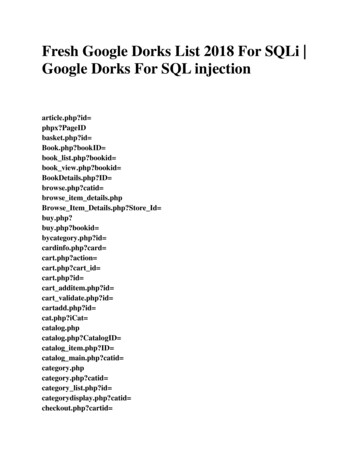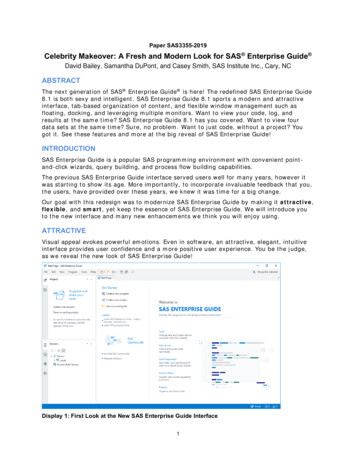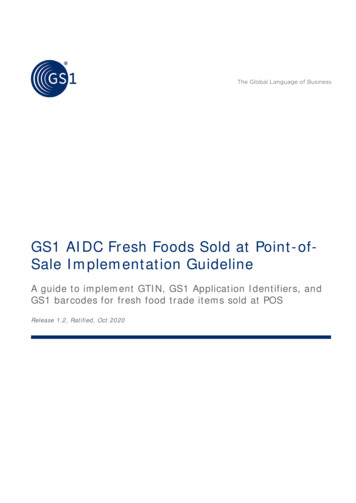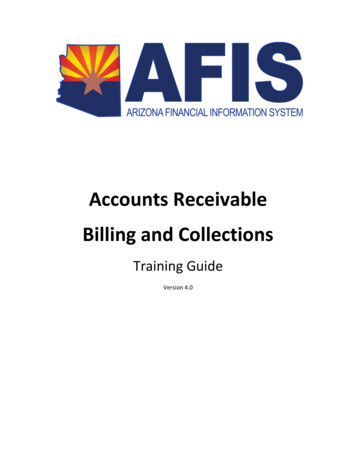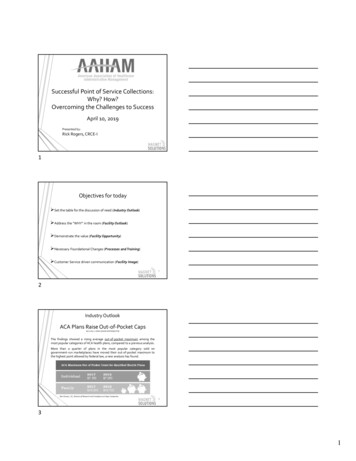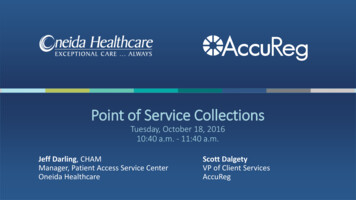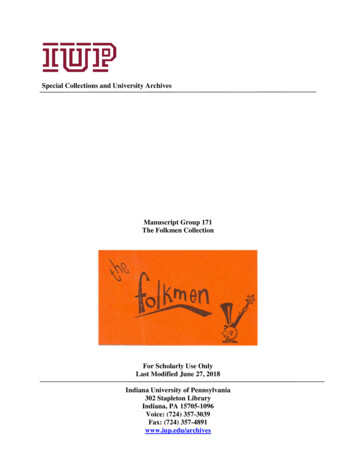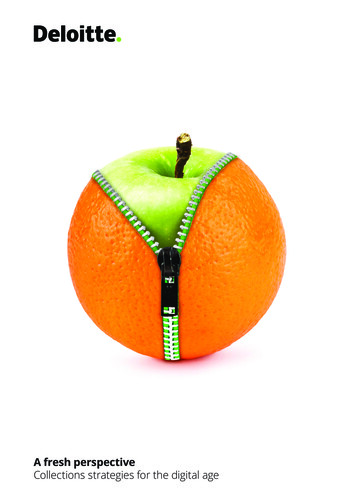
Transcription
A fresh perspectiveCollections strategies for the digital age
ContentsIntroduction5Strategy, appetite and policy8Risk governance and organisation10Data and definitions11Process management13Information technology14Analytics16Communication and management information18Skills and resources19Validation and assurance21Contacts26
IntroductionConsumer indebtednessConsumer indebtedness withinthe South African market posesa serious challenge for lenderstrying to grow their portfolios organically.With the unbanked population of adultsin South Africa currently at 13%, firmsmay struggle to identify those pocketsof the market in which they could safelyexpand. With consumers battlingpetrol prices and food inflation fuelledby a weakening Rand the flexibility toincrease spending has been strained.Tighter underwriting criteria have beeninstituted over the past few years asfirms have closed off the taps, but as aresult, those customers who now fallinto arrears may well be the toughestand most idiosyncratic cases, which aresignificantly harder to recover.1Macroeconomic concernsWith impending fears of a creditrating downgrade coupledwith increasing interest rates,the South African economic outlookgrowth currently at its lowest since the2008/2009 recession. Unsurprisingly,the unemployment rate is at its highestin ten years and investor confidence issignificantly lagging. Policymakers nowhave fewer tools and much less scopeto help us out should another big shockhit the global economy. The previousengines of economic growth havebegun to falter as Chinese growth slowsdown, world GDP forecasts are beingtrimmed and productivity gains fromnew technology begin to peter out. TheGDP growth outlook places the economyon the edge of a recession while manybelieve we are already there.2Changing attitudes towards debtThere was a time when debt hada stigma and bank managerswere figures of authority.Bankruptcy was reserved for thedesperate. Customers nowadays mayassociate banks with reckless lendingor Forex manipulation rather thantheir friendly local bank manager. Andresearch suggests that what somepeople prioritise when the cash flowruns low are their cell phone and theircredit card. To be disconnected is tobe disenfranchised. Meanwhile, sinceowning your own home has becomea distant dream for more and morepeople, there is less motivation tomaintain a perfect credit score.Reinforcing these trends, social mediahave revolutionised the range ofinformation available to people in debt.A swift online search returns details ofdebt forums where people share hints,tips and – sometimes – debt avoidancestrategies. Customers can easilyresearch the different processes used bydebt collection agencies, including whattype of letter to expect, in what order,and how best to respond. While much ofthe advice may be bogus or misleading, itstill creates work for a collections team.Changing attitudes towards debtorsGiven the choice, lendersgenerally prefer their customersnot to have been in collectionselsewhere. After all, a spell in arrearsdoes nothing for one’s credit score.However, banks are increasinglyrealising that many people nowadayshave experience of being in collections,and that they can’t afford to turn awayall such clients. As a result, they nolonger see customers in collections asirredeemably bad credits and they havegreater incentives to maintain brandloyalty so that when the customer is inbetter financial health, they will considerreturning to that lender.43Collections strategies for the digital age 5The signs are thatnow could be a goodtime to invest incollections – whichis also an admissionthat things could beabout to get worse.
The regulator’s focus on conduct andconsumer protectionWith the impending creation ofthe Financial Service ConductAuthority under the Twin Peaks Bill,recent focus within the industry hasbeen to prioritise protecting consumersand managing conduct risk. Marketconduct regulation will require higherstandards than general consumerprotection laws. The previous lighttouch approach to regulation has beenreplaced with a more hands-on attitudethat focuses on culture, strategy andremuneration – and how they lead togood or bad outcomes for customers.Developments in the recent pastfrom regulators include: regulationwhich prohibits the re-collection orre-activation of debt that has beenextinguished by prescription; regulationwhich required all credit bureaus toremove adverse credit informationon all customers held within theirdatabases as at 1 April 2014 (creditinformation amnesty) and increasedscrutiny surrounding the issuance ofunsecured lending due to the recent‘reckless lending’ debacle experiencedby the industry. This regulatory focus isexpected to continue and possibly evenintensify going forward.5TechnologyCan your dialler send an SMSto a customer the moment itrecognises an engaged tone?Would your collections platformallow that same customer to go fromyour email reminder to a direct debitinstruction on your website within acouple of clicks? Do all your call centrestaff have access to intuitive dashboardswith a single customer view with all therelevant information? Is your collectionsplatform flexible enough to enableyour analytics team to test and adaptstrategies within a few hours? And doesyour technology in general automate6the mundane, low-value activities whileimproving transparency and auditability?If not, then somebody somewhere –most likely at a rival – will have a satisfiedsmile on their face.Integrated analyticsWe live in a knowledge economy.Admittedly that’s a cliché. But notevery firm in the industry seemsto realise that clichés are based on truth.A collections function that can get thebetter of its rivals in terms of modellingthe cost to collect, likelihood of recoveryand most efficient strategy will be betterplaced to buy or sell debt at the rightprice. It will also be able to collect onmore accounts, more quickly and moreprofitably.7The richness of data feeds now availableonly enhances the potential returns ofsmart analytics. By integrating analyticsinto strategy setting, collections teamscan not only improve expected margins,they can flag up early trends that maycall for a change in the strategy. Ask notjust what you can do for your collectionsfunction, ask what your collectionsfunction can do for you.More debt thanever has becomecollectable at anaffordable price Collections strategies for the digital age 6
IFRSThe new accounting standardfor the calculation of impairmentresults, replacing IAS 39,comes into force in January 2018. Justsecuring compliance is proving enoughof a headache for many firms. Few willhave thought about the consequencesfor their early arrears management,collections and recoveries teams – andthe possible contribution those teamscould make towards lower impairmentbalances and better returns on capital.8To put the new rules simply, allaccounts fall into one of three bucketsor ‘stages’. Stage 1 accounts compriseall those loans performing in-linewith expectations when the loan wasoriginated (typically not in collections).Accounts move to Stage 2 whenthey have shown ‘significant creditdeterioration’, while Stage 3 accountsare those in default. For Stage 1accounts, the impairment calculationis based on a 12-month expected loss(what you’d expect to lose on thataccount over the remaining lifetimeusing the probability of defaulting overthe next year; typically very little). But assoon as an account enters Stage 2, theimpairment requirement becomes theexpected loss for the entire lifetime ofthe loan (typically a lot more).The incentives to set up pre-arrearsfunctions will become more striking.Collection teams who successfullymanage customers back from the edgeof Stage 2 will be saving their firms asubstantial amount of impairment.The P&L and balance sheet benefitsof curing an account from Stage 2 toStage 1 will also be greater. The valueand benefits of a good collectionsoutfit will therefore become easier tomeasure – and the focus on collectionseffectiveness will rise.Deloitte’s Tier Structure ModelWith so many interlocking trends andmarket dynamics, firms should look athow incremental changes across thewhole of their operations can contributetowards greater business success.It can be hard to secure investmentand harder still to know where toprioritise your spend. Our Tier StructureModel (see page 24) has helped firmstarget improvements throughouttheir businesses, often withoutsignificant outlay. A hundred modestimprovements can achieve remarkableshifts in relative performance.In the remainder of this review, weanalyse the nine elements of the TSM,and share our experience on what theindustry’s leading firms are doing ineach area, why they’re doing it and howthey’ve got there.The incentives to set up pre-arrears functionswill become more striking. Collection teams whosuccessfully manage customers back from the edgeof Stage 2 will be saving their firms a substantialamount of impairment.Collections strategies for the digital age 7
Strategy, appetite and policyLet’s start at the topIf your collections staff don’t understandhow your risk appetite framework relatesto them, then you don’t have a very goodrisk appetite framework. Why? Becauseone of the primary goals of such aframework is to connect the day-to-dayactivities of your staff with the Boardapproved risk appetite. Step one is toexplain your desired risk profile. Step twois explaining to individuals what they cando to keep the firm on track and what itmeans to them in their day to day role.To take a simple example, a collectionsteam without strategic awareness mayfocus on collecting promises ratherthan sustainable reductions in arrears;they may not understand that eachR100 removed from arrears may saveR2 000 from the firm’s impairmentstocks. Simply by understanding thatlink, the more advanced firms are able tomotivate better behaviours, boost staffengagement and most importantly leadto higher numbers of good customeroutcomes. When risk appetite isexpressed in only simple terms, though,it can often focus on broad lendingmetrics which may not mean very muchto a collections team.The more sophisticated firms articulateand communicate their risk appetitein both financial and non-financialterms, giving clear direction on how tomanage conduct and reputational riskas well. Done well, it helps firms monitorperformance against their strategy inboth financial terms and the impact oncustomers.The well-established risk appetiteframeworks use both lower and uppertrigger points for their metrics to signalwhere they need to reduce risk andalso where they can comfortably takeon additional risk. And they use thatknowledge to prioritise activities withintheir collections teams. For instance,they redirect staff from product toproduct or segment to segment to helpthe firm keep within its overall desiredrisk profile.Within the overarching risk managementstrategy of these firms, the collectionsstrategy is both clear and detailed:the desired outcomes are specified ina variety of consistent ways and notjust in terms of rands collected. Wesee the most advanced firms breakingdown the desired outcomes of theirstrategies by segment and also bycustomer outcomes. Done properly,your collections staff will understandhow they contribute to the firm’s overallrisk appetite objectives. Moreover, yourBoard and management will be able toadequately review and challenge thecollections team’s performance in abalanced way by measuring not just theamount collected but also the outcomesthat customers are receiving.Strategies for arrears managementwill have multiple objectives, rangingfrom generating sufficient profitabilityto maintaining good relations withthe regulator and upholding a goodreputation with the public. Under theTwin Peaks Bill, firms that fail to deviseand demonstrate appropriate treatmentstrategies for customers in arrears couldface hefty and painfully public fines.Collections strategies for the digital age 8Whether in defining an overall strategyor the process of trialling strategiesfor particular risk segments, the mostsophisticated firms in the industry havebeen smart in linking their strategiesto incentives and remuneration plans,training, IT and organisational design.The focus by regulators on goodcustomer outcomes has put the onuson individual firms to put in place notjust strategies but also policies. And notonly policies, but a culture of adhering topolicies – and being able to demonstratecompliance to senior management,internal audit and the regulator.The more sophisticatedfirms articulate andcommunicate theirrisk appetite in bothfinancial and nonfinancial terms, givingclear direction on howto manage conduct andreputational risk as well.
The best-placed firms can show that aclear, appropriately detailed policy is inplace, that is understood and followedby the relevant staff. Doing it well savestime and money, encourages loyalty andcontributes to brand reputation.Like all of the most interesting problemsin business, there is no perfect solutionwhen writing a policy for your collectionsfunction. If you are too general you won’thave given your staff the guidance theyneed to keep your firm both competitiveThe best-placed firms can show that a clear,and compliant. However, if you are tooappropriately detailed policy is in place, that is has beenprescriptivewillstafffail andto takeunderstoodby theyourelevantthat itintois followed.accountyourcustomers’particularDoing it well saves time and money, encourages loyaltyandcontributes to brand reputation.situations.The solutions we’ve seen work wellenable firms to demonstrate how theyidentify what good outcomes look like fortheir customers and how their treatmentstrategies have achieved them. Just asimportantly, though, they also have aclear picture of what constitutes a badoutcome and have MI in place to monitorperformance against expectations –alongside documented policy provisionthat stipulates governance andappropriate response
Strategy, appetite and policy 8 Risk governance and organisation 10 Data and definitions 11 Process management 13 Information technology 14 Analytics 16 Communication and management information 18 Skills and resources 19 Validation and assurance 21 Contacts 26. Collections strategies for the digital age 5 Consumer indebtedness Consumer indebtedness within the South African market poses a .
